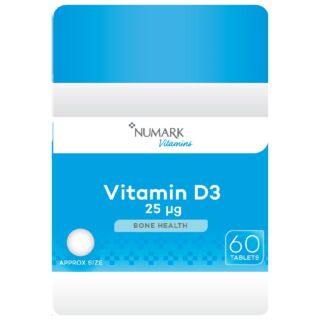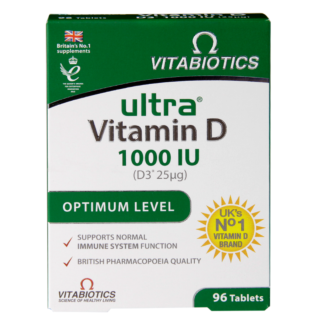Vitamin D: Everything You Need to Know
Vitamin D, often called the “sunshine vitamin”, is essential for your bones and teeth, muscles, and immune system. But as the dark nights draw closer, your main source of vitamin D is disappearing.
Don't worry! We'll cover everything under the sun about vitamin D, from how much you need daily and when to take supplements, to spotting deficiency signs and understanding the full range of vitamin D benefits.
Three key takeaways
- What it does: Vitamin D helps absorb calcium for strong bones and teeth, supports immune function to fight infections, and maintains muscle strength.
- Dosage recommendation: Take 10mcg (400 IU) daily from October to March when UK sunlight is too weak, and year-round for those at a higher risk of deficiency.
- How to get it: Aim for 15-30 minutes of sun exposure a day between April and September, and eat oily fish and fortified foods, but rely on daily supplements during autumn and winter.

What is vitamin D, and what does it do?
Vitamin D is a fat-soluble vitamin, meaning your body stores it in fat tissue and can keep reserves for a long time.
Your body produces it when sunlight touches your skin, converting cholesterol into vitamin D. It exists in two main forms: D2, which is found in plant sources (certain vegetables), and D3, which is produced through exposure to sunlight and is in some animal-based and fortified foods.
It’s also essential for your body to absorb calcium from your diet, or when taking supplements. Beyond strengthening your bones through calcium, it also supports your immune cells in fighting infections, reduces inflammation, and maintains muscle strength.
How much vitamin D do you need per day?
The government recommends that everyone should take 10mcg (400 IU) of vitamin D a day from October to March. From April to September, most adults are able to make enough vitamin D from sunlight.
However, there are some groups at a higher risk of deficiency who should consider year-round supplements, including:
- children aged between one and four
- pregnant and breastfeeding women
- people with darker skin
- people who cover most of their skin outdoors
- people who spend little time outside
Despite this advice, roughly one in six UK adults and 20% of children have vitamin D deficiency. Use our vitamin D calculator below to find out how much you should be taking.
Vitamin D calculator
Unsure whether you need a vitamin D supplement? Use our easy vitamin D calculator to find out! Calculate your ideal daily intake based on your weight and how much sun and skin exposure you get on average.
Vitamin D Calculator
Calculate your daily vitamin D needs based on sun exposure
Your Results
Daily Vitamin D Requirement:
Vitamin D from Sun Exposure:
Additional Vitamin D Needed:
How to Get Your Vitamin D
Food Sources (per serving):
- Salmon (100g): 400-1000 IU
- Mackerel (100g): 360 IU
- Sardines (100g): 270 IU
- Egg yolk (1 large): 40 IU
- Fortified milk (1 cup): 100 IU
- Fortified cereals (1 serving): 40-100 IU
- Mushrooms exposed to UV (100g): 400 IU
Supplementation:
Consider vitamin D supplementation to meet your daily needs:
- Standard vitamin D3 supplements: 1000 IU (25 mcg) or 2000 IU (50 mcg) tablets
- Vitamin D spray for easier absorption
- Combined calcium + vitamin D supplements
Note: This calculator provides estimates only. Consult your GP or pharmacist for personalised advice, especially if you have limited sun exposure, darker skin, or specific health conditions.
How to spot vitamin D deficiency
Spotting signs of vitamin D deficiency can be tricky, as the symptoms can often be subtle, and not everyone will experience them.
Symptoms may include:
- persistent tiredness and fatigue
- bone pain or aching, particularly in your back, hips, and legs
- muscle weakness, cramps, or general body aches
- frequent colds, flu, or respiratory infections
- low mood or feeling down, especially in winter
- slow wound healing or recovery from illness
- hair loss or thinning in severe cases
However, you can’t diagnose a vitamin D deficiency based on symptoms alone. A simple blood test measuring your vitamin D levels is the only way to know for certain.
Benefits of vitamin D
- Stronger bones and teeth. Vitamin D helps your body absorb calcium and phosphate, preventing osteoporosis, fractures, and rickets in children.
- A stronger immune system. It strengthens your body's defence against infections, particularly respiratory illnesses like colds and flu.
- Reduced inflammation. Vitamin D helps control inflammatory responses throughout your body, potentially lowering the risk of chronic diseases.
- Better mood. It may help prevent seasonal affective disorder (SAD) and support overall mental health.
- Lower infection risk. Studies suggest vitamin D may reduce the severity of respiratory infections.
Sources of vitamin D
You can get vitamin D from three main sources: sunlight, certain foods, and supplements, with sun exposure being one of the best methods.
Sunlight
Your skin produces vitamin D when exposed to UVB rays from sunlight, generating up to 10,000-20,000 IU in just 15-30 minutes of summer sun exposure.
In the UK, you can only significantly make vitamin D from sunlight between April and September. And even then, only really between 11am and 3pm, when the sun is at its highest.
Most people with lighter skin need about 15-20 minutes of sun on their arms and face several times a week, while those with darker skin may need upwards of 40 minutes.
Food
Vitamin D-rich foods include:
- oily fish (salmon, mackerel, sardines, herring)
- egg yolks
- red meat and liver
- fortified foods like breakfast cereals, plant-based milks, and margarine
- cod liver oil
However, it can be tough to get all of your vitamin D needs through food alone. For example, eating oily fish twice a week typically provides only 20-30% of your vitamin D requirements.
Supplements
Taking vitamin D supplements is a simple, reliable way to maintain healthy levels throughout the year. You'll find two types: D2 (plant-based) or D3 (animal-based), with D3 working better in your body.
Most supplements contain 10-25mcg (400-1000 IU) and come as tablets, capsules, sprays, or drops.
How to increase your vitamin D intake
The most effective ways to boost your vitamin D levels are by taking daily supplements, getting safe sun exposure during the summer months, and including vitamin D-rich foods in your diet.
If you’re unsure whether you should take a supplement, use our vitamin D calculator above.
Should you take vitamin D every day?
During the summer months, most adults can make enough vitamin D from sunlight alone. Only young children and those at a higher risk of being deficient should take it year-round.
However, everyone should supplement their vitamin D during autumn and winter. Taking a daily dose is generally recommended and is more effective than taking larger doses weekly or monthly.
Can you take too much vitamin D?
Yes, you can overdose on vitamin D by taking extremely high doses of supplements over time, causing calcium buildup that can damage your kidneys, heart, and bones.
Vitamin D overdose, also called vitamin D toxicity, cannot happen from sun exposure or food. Your body naturally regulates vitamin D from sunlight, and foods don't contain dangerous amounts.
However, taking more than 100mcg (4,000 IU) daily for several months can lead to hypercalcaemia, where too much calcium builds up in your blood.
Symptoms of vitamin D overdose include:
- nausea, vomiting, and loss of appetite
- excessive thirst and frequent urination
- confusion or difficulty concentrating
- kidney stones or kidney damage
- irregular heartbeat
- muscle weakness and fatigue
- bone pain
How Chemist4U can help you get more vitamin D
Chemist4U offers a range of vitamin D supplements to help you maintain healthy levels year-round, with options for the whole family.
We stock trusted brands in various formats, including tablets, capsules, gummies, drops, and sprays. Our range includes standard 10mcg (400 IU) daily supplements, as well as 25mcg (1000 IU) and above for those needing extra support.
We also provide child-friendly drops and gummies, plus combination supplements that pair vitamin D with calcium to help maintain strong, healthy teeth and bones.
Our pharmacists can guide you towards the right supplement for your needs, whether you're looking for vegetarian D2 options or D3.
With competitive prices and convenient home delivery, browse our full vitamin D range online or speak to our pharmacy team for personalised advice.
FAQs
How much vitamin D do you need during pregnancy?
Pregnant and breastfeeding women need 10mcg (400 IU) daily throughout pregnancy and breastfeeding to support their baby's bone, teeth, and organ development. The NHS recommends all pregnant women take vitamin D supplements year-round, as getting enough from food and sunlight alone is difficult, particularly during UK winters.
How much vitamin D do children need?
Babies under one year need 8.5-10mcg daily, while children over one need 10mcg daily. All babies should receive vitamin D drops unless drinking 500ml+ of formula daily. Children aged one to four should take supplements year-round, and older children should consider them during autumn and winter.
Is D3 the same as vitamin D?
Vitamin D3 is one of two main forms, alongside D2. Both work, but D3 is more effective at raising and maintaining blood levels. Your body naturally produces D3 from sunlight, whilst D2 comes from plant sources. Most supplements use D3 for better results.
How long does it take vitamin D to work?
Although you may feel improvements within 3-4 weeks, it typically takes 2-3 months for the benefits of vitamin D to really kick in. It might take up to 6 months, meanwhile, to address a severe deficiency using vitamin D supplements.
Does sunscreen block vitamin D?
No, there’s little evidence to prove that high SPF sunscreen blocks vitamin D production. Always use a minimum of SPF 30 to prevent skin damage from the sun’s UV rays.
Can you get vitamin D through a window?
No, windows block the UVB rays needed for vitamin D production. Even sitting in a sunny conservatory won't help your levels. You need direct sunlight on bare skin or supplements to maintain healthy levels.
Can you take magnesium with vitamin D?
Yes, taking them together is safe and beneficial. Magnesium helps activate vitamin D so your body can use it properly. Many people with vitamin D deficiency also have low magnesium, which can prevent it from working effectively.
What fruit contains vitamin D?
Fruits don't naturally contain vitamin D. Only UV-exposed mushrooms (technically fungi) contain small amounts. Some orange juice brands are fortified with vitamin D, but check the labels. Focus on oily fish, eggs, fortified foods, and supplements instead.
Can you get vitamin D from milk?
Most UK cows' milk isn't fortified with vitamin D, unlike in the USA. However, many plant-based milks (soy, oat, almond) are fortified. Some UK dairy brands now offer vitamin D-fortified milk, providing about 1-3mcg per serving.
Sources
- Adult Vitamin D Guidelines. October 2023. South East London ICS. Accessed 13th October 2025.
- Vitamin D. StatPearls. NCBI Bookshelf. Accessed 13th October 2025.
- Vitamin D Supplementation: A Review of the Evidence for Optimal Health. 2011. PMC. Accessed 13th October 2025.
- Vitamin D. NHS. Accessed 13th October 2025.
- New Review Launched into Vitamin D Intake to Help Tackle Health Disparities. GOV.UK. Accessed 13th October 2025.
- Vitamin D Deficiency: Supplements Reduce Inflammation. Medical News Today. Accessed 13th October 2025.
- Seasonal Affective Disorder (SAD). NHS. Accessed 13th October 2025.
- Vitamin D and Depression: A Systematic Review and Meta-Analysis. 2025. PubMed. Accessed 13th October 2025.
- Vitamin D and Calcium: A Systematic Review of Health Outcomes. 2007. PMC. Accessed 13th October 2025.
- Vitamin D Toxicity (Hypervitaminosis D). Cleveland Clinic. Accessed 14th October 2025.
- Vitamins, Supplements and Nutrition in Pregnancy. NHS. Accessed 14th October 2025.
- Vitamins for Babies. NHS. Accessed 14th October 2025.
- Effect of Vitamin D Supplementation on Muscle Strength. 2023. PubMed. Accessed 14th October 2025.
- Vitamin D Toxicity–A Clinical Perspective. 2018. PubMed. Accessed 14th October 2025.
- Vitamin D Intoxication with Severe Hypercalcemia. 2018. PubMed. Accessed 14th October 2025.











